Curious about the exact temperature at which candle wax melts? You’re in luck because we have the answer right here!
Understanding the melting point of candle wax is crucial for those who want to create the perfect candles for their loved ones or customers. Different types of candle wax have different melting points, and knowing these points can make a big difference in the quality of your candles.
For instance, let’s take the example of paraffin wax. Its melting point is around 130 to 140 degrees Fahrenheit. By understanding and testing the melting points of various waxes, you can ensure that your candles burn evenly and last longer.
So, let’s dive into the fascinating world of candle wax melting points and discover how it can elevate your candle-making skills!
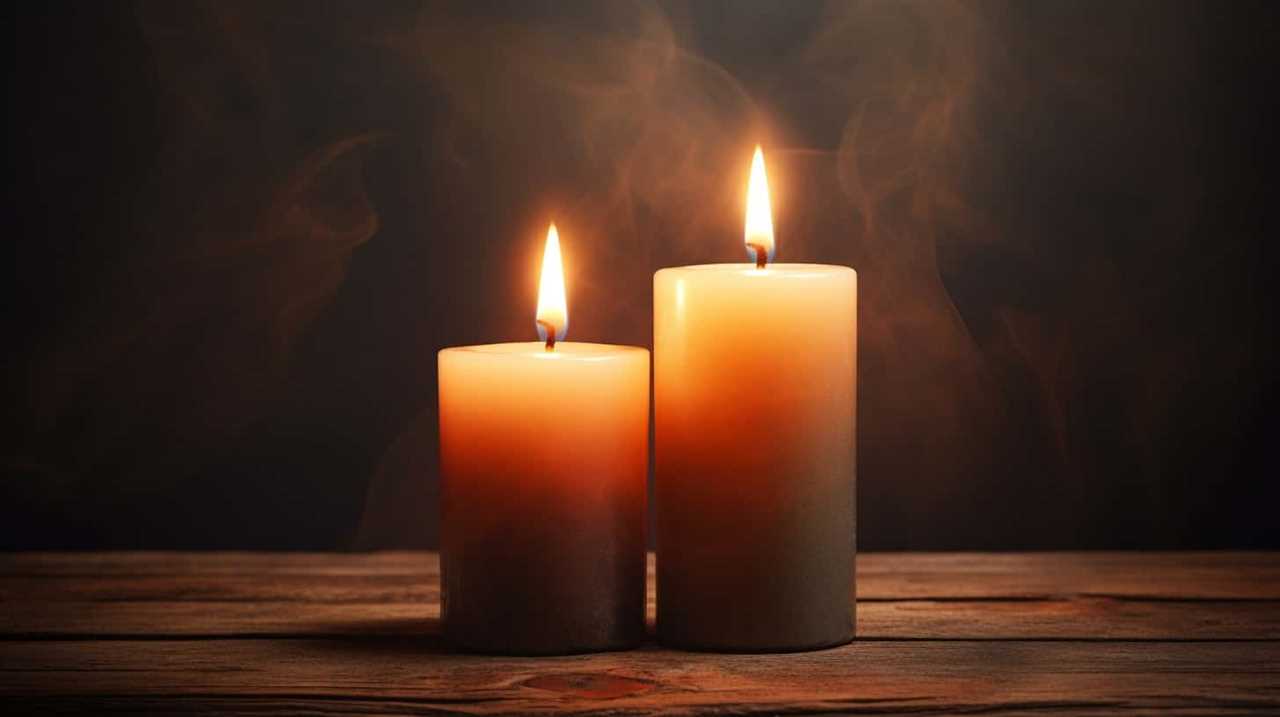
Key Takeaways
- The melting point of candle wax is the temperature at which it transitions from a solid to a liquid state.
- The melting point is important in determining the quality, performance, and behavior of candles.
- Different types of candle wax have different melting points, which affect factors such as burn time and fragrance release.
- Factors that influence the melting point of candle wax include the composition of the wax, heat source, impurities, additives, and container size and shape.
What Is Melting Point
The melting point is the temperature at which a substance transitions from a solid to a liquid state. It’s an important characteristic of a substance, as it helps determine its physical properties and behavior.
Temperature control is crucial in various industries where accurate melting points are required for manufacturing processes. For example, in the pharmaceutical industry, knowing the melting point of a drug substance is essential to ensure its stability and effectiveness.
Impurities can have a significant impact on the melting point of a substance. Even small amounts of impurities can lower the melting point, affecting the integrity and quality of the final product. Therefore, maintaining proper temperature control and minimizing impurities are vital in order to ensure consistent and reliable results in various applications.
Importance of Melting Point for Candles
In our experience with candle making, we’ve found that the melting point of candle wax plays a crucial role in determining the quality and performance of the final product. The importance of temperature control can’t be overstated when it comes to candle making.
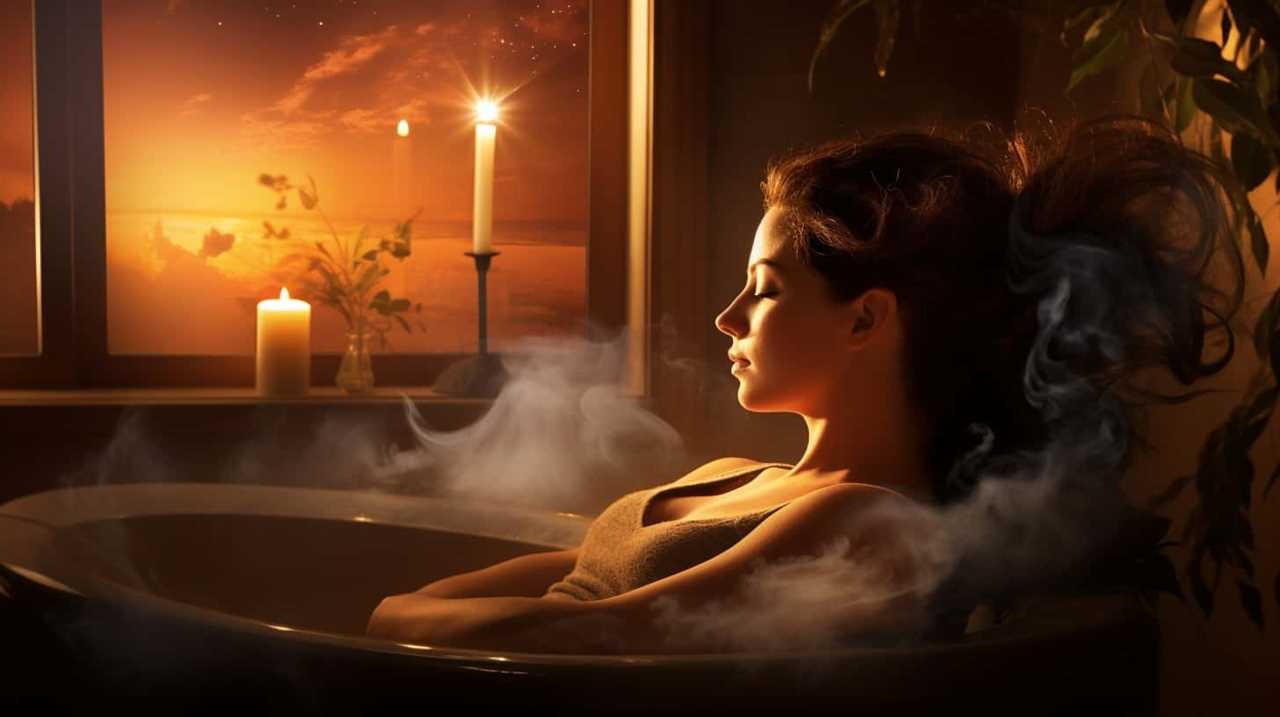
When the wax is melted at the correct temperature, it ensures that the fragrance oils are properly dispersed and that the candle burns evenly and cleanly. If the wax is overheated, it can result in poor scent throw and a weaker fragrance. On the other hand, if the wax isn’t heated enough, the candle may not burn properly or may have a shorter burn time.
Additionally, the melting point of the wax can be affected by the use of additives, such as colorants or fragrance oils. These additives can alter the wax’s melting point, so it’s important to carefully consider their effects when formulating candle recipes.
Types of Candle Wax
When it comes to candle making, we rely on different types of candle wax depending on our specific needs and preferences. Here are four types of candle wax commonly used:
- Paraffin Wax: This petroleum-based wax is widely used due to its affordability and versatility. It has a high melting point, which makes it ideal for creating strong and long-lasting candles.
- Soy Wax: Made from soybean oil, this natural wax is a popular choice among environmentally conscious individuals. It has a lower melting point compared to paraffin wax, resulting in a slower and cleaner burn.
- Beeswax: Derived from bees, this natural wax is known for its sweet scent and golden hue. It has a higher melting point and produces a warm, soft glow when burned.
- Palm Wax: Made from palm oil, this renewable wax has a unique crystalline structure that gives candles a beautiful feathered appearance. It has a moderate melting point and provides excellent scent throw.
Understanding the differences between paraffin wax vs soy wax and beeswax vs palm wax allows us to choose the right type of candle wax for our specific needs, whether it’s for fragrance, sustainability, or aesthetic purposes.
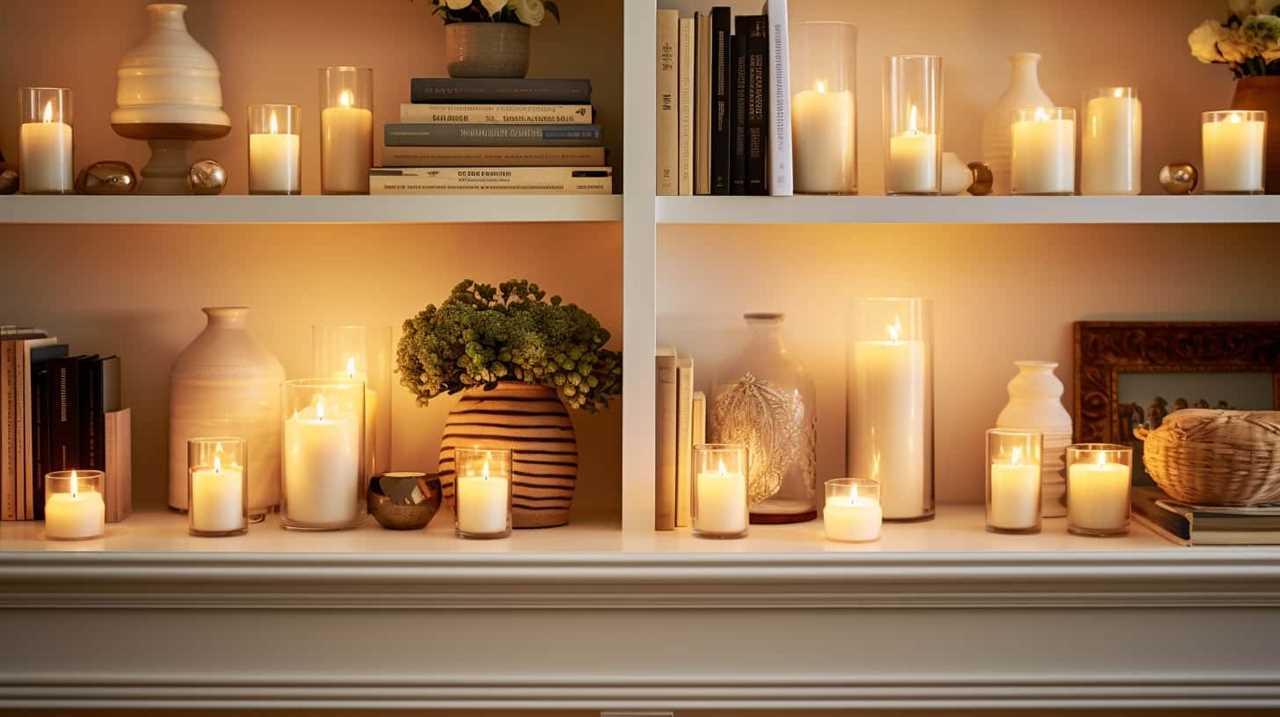
Factors Affecting Melting Point
To understand the factors affecting the melting point of candle wax, we need to consider various elements that play a role in determining this characteristic.
One crucial factor is the composition of the candle wax. Different types of wax, such as paraffin, beeswax, or soy wax, have different melting points due to variations in their chemical composition. For example, paraffin wax has a lower melting point compared to beeswax, making it easier to melt.
Another factor that influences the melting point is the heat source. The temperature and intensity of the heat source can significantly affect the melting point of the wax. A higher heat source will increase the rate of heat transfer, causing the wax to melt at a lower temperature.
Therefore, understanding the candle wax composition and the influence of the heat source is essential in determining the melting point of candle wax.
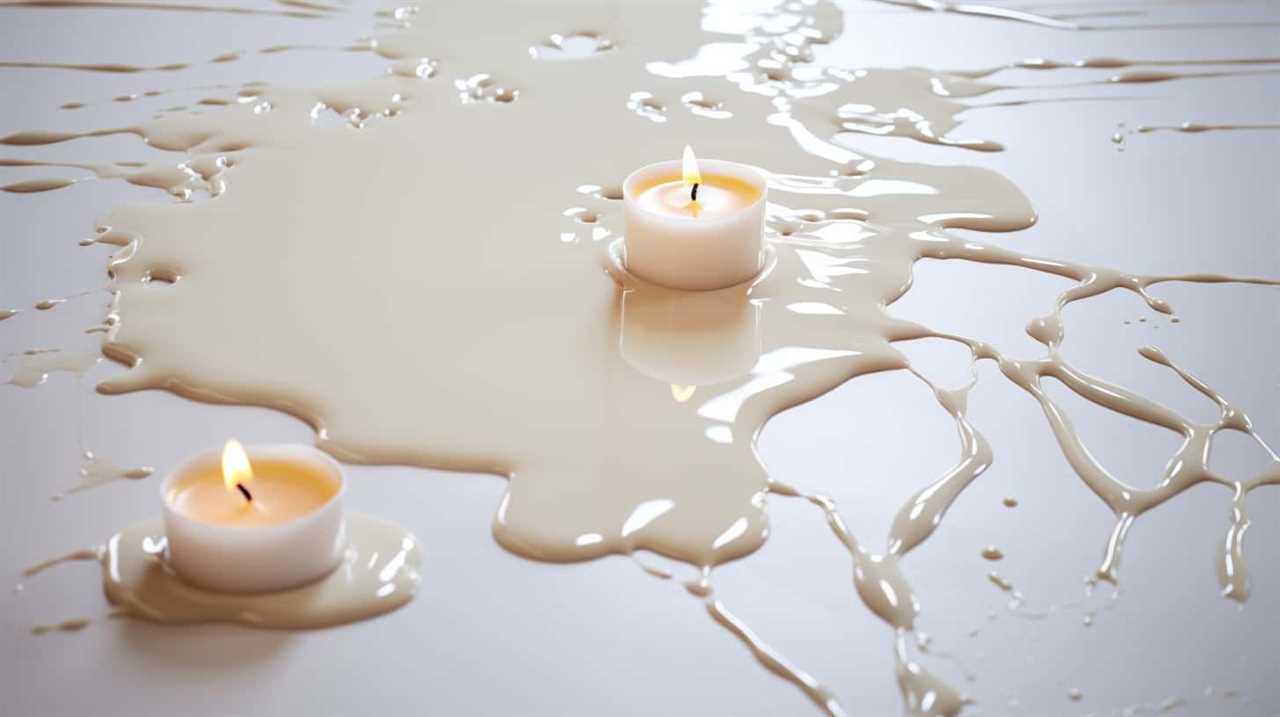
Paraffin Wax and Its Melting Point
When considering the melting point of paraffin wax, it’s important to analyze the factors that affect it. These factors include the molecular structure, purity of the wax, and any additives present.
Additionally, comparing the melting points of different waxes can provide valuable insights into their composition and applications.
Factors Affecting Melting Point
Our research has revealed several factors that influence the melting point of paraffin wax. These factors include:
- Impurities: The presence of impurities, such as additives or contaminants, can lower the melting point of paraffin wax. Higher purity wax tends to have a higher melting point.
- Crystalline Structure: The crystalline structure of paraffin wax can vary depending on factors like the length of the hydrocarbon chain. Waxes with longer chains tend to have higher melting points.
- Molecular Weight: The molecular weight of the wax molecules also affects the melting point. Higher molecular weight waxes generally have higher melting points.
- Temperature Range: The temperature range over which paraffin wax melts can vary depending on the specific formulation and purpose. Different types of paraffin waxes may have different melting points and melting temperature ranges.
Understanding these factors can help in selecting the appropriate paraffin wax for specific applications, ensuring optimal performance and usability.
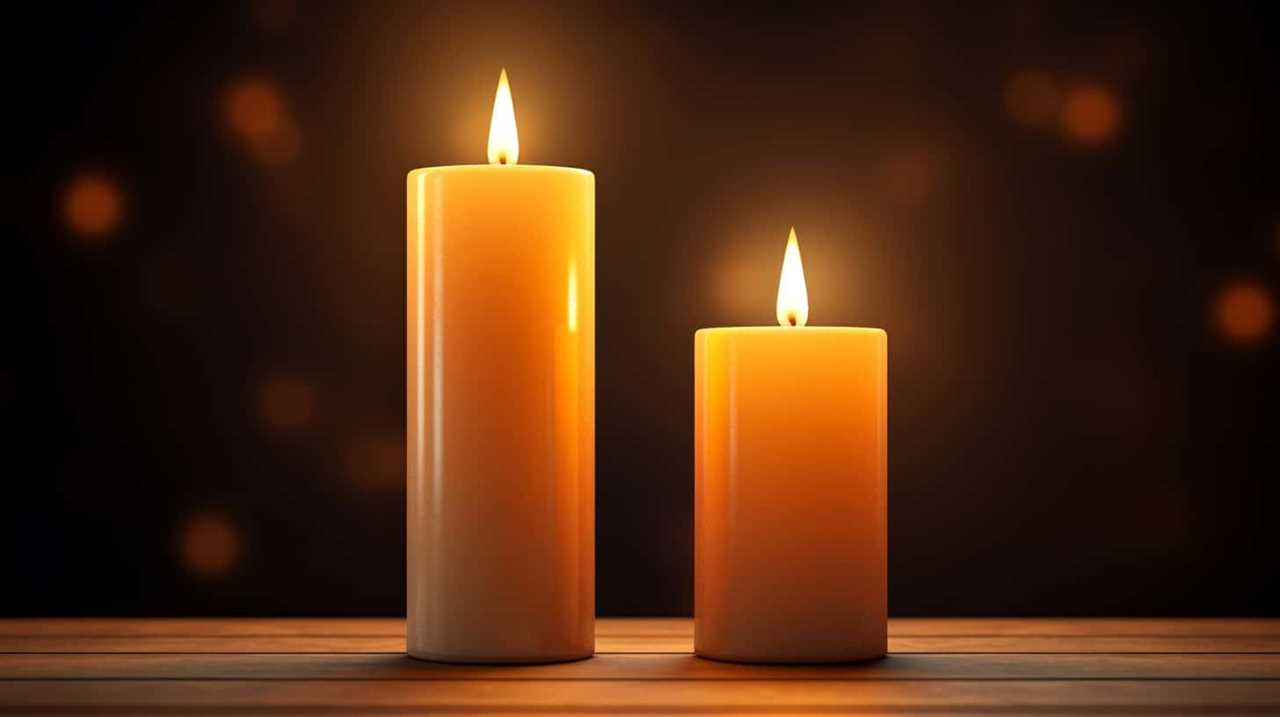
Comparing Different Waxes
We will compare the melting point of paraffin wax to that of other waxes. Comparing melting points is important because it directly affects the performance of a candle.
Paraffin wax, which is derived from petroleum, has a melting point between 120°F and 160°F (49°C to 71°C). This relatively low melting point allows the wax to liquefy quickly when the candle is lit, ensuring a consistent and even burn. Paraffin wax also has a high fragrance capacity, making it a popular choice for scented candles.
Other waxes, such as beeswax and soy wax, have higher melting points. Beeswax melts between 144°F and 147°F (62°C to 64°C), while soy wax melts between 120°F and 180°F (49°C to 82°C). The melting point of a wax can impact the candle’s ability to release fragrance and its overall burn time.
Transitioning to the subsequent section, we’ll now explore soy wax and its melting point.
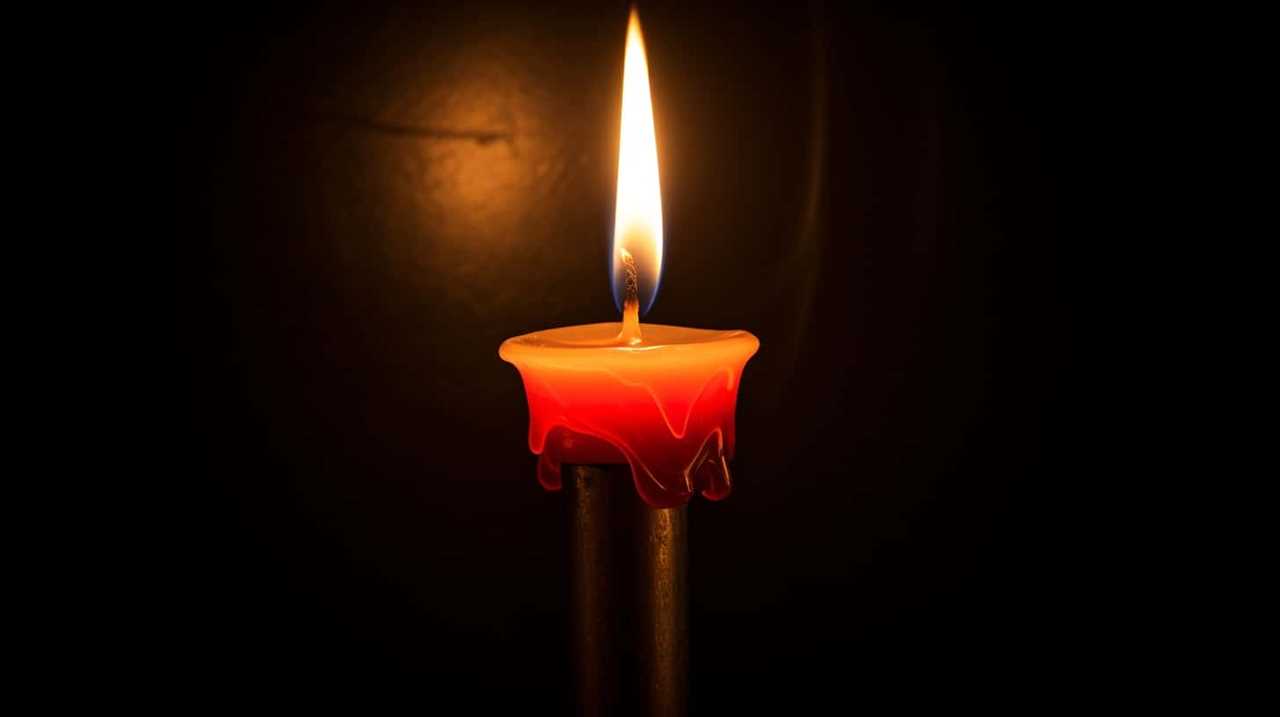
Soy Wax and Its Melting Point
Soy wax has a melting range of approximately 120 to 180 degrees Fahrenheit, making it a suitable choice for candle making.
The melting point of soy wax can be influenced by various factors such as the specific blend of oils used and any additives included.
When compared to other waxes, soy wax tends to have a lower melting point, allowing for a longer burning time and a more gradual release of fragrance.
Soy Wax Melting Range
Typically, soy wax melts at a relatively low temperature, often requiring frequent monitoring during the melting process.
Some key properties of soy wax that contribute to its melting range include:
- Low melting point: Soy wax has a melting point range of around 115 to 125 degrees Fahrenheit (46 to 52 degrees Celsius). This low melting point allows it to melt easily and evenly when exposed to heat.
- Slow cooling: Soy wax has the advantage of a slow cooling process, which results in a longer burning time for candles made from this wax.
- Clean burning: Soy wax is known for its clean and soot-free burn, making it a popular choice for those concerned about air quality.
- Compatibility with fragrance oils: Soy wax has a high fragrance load capacity, allowing it to hold and release scents effectively.
Understanding the melting range of soy wax is crucial for candle makers and enthusiasts to ensure proper melting and pouring techniques, ultimately resulting in high-quality candles.

Factors Affecting Melting
Frequently, candle makers and enthusiasts encounter various factors that influence the melting point of soy wax. These factors can have a significant impact on candle performance and efficiency.
One of the key factors affecting the melting point of soy wax is the type of additives used. Certain additives, such as stearic acid or vybar, can raise the melting point of the wax, making it more suitable for specific candle types or environments.
The purity of the soy wax also plays a role, as impurities can lower the melting point and affect the overall quality of the candle.
Additionally, the container size and shape can influence the melting point, as larger containers may require higher melting points to ensure proper scent throw and burn time.
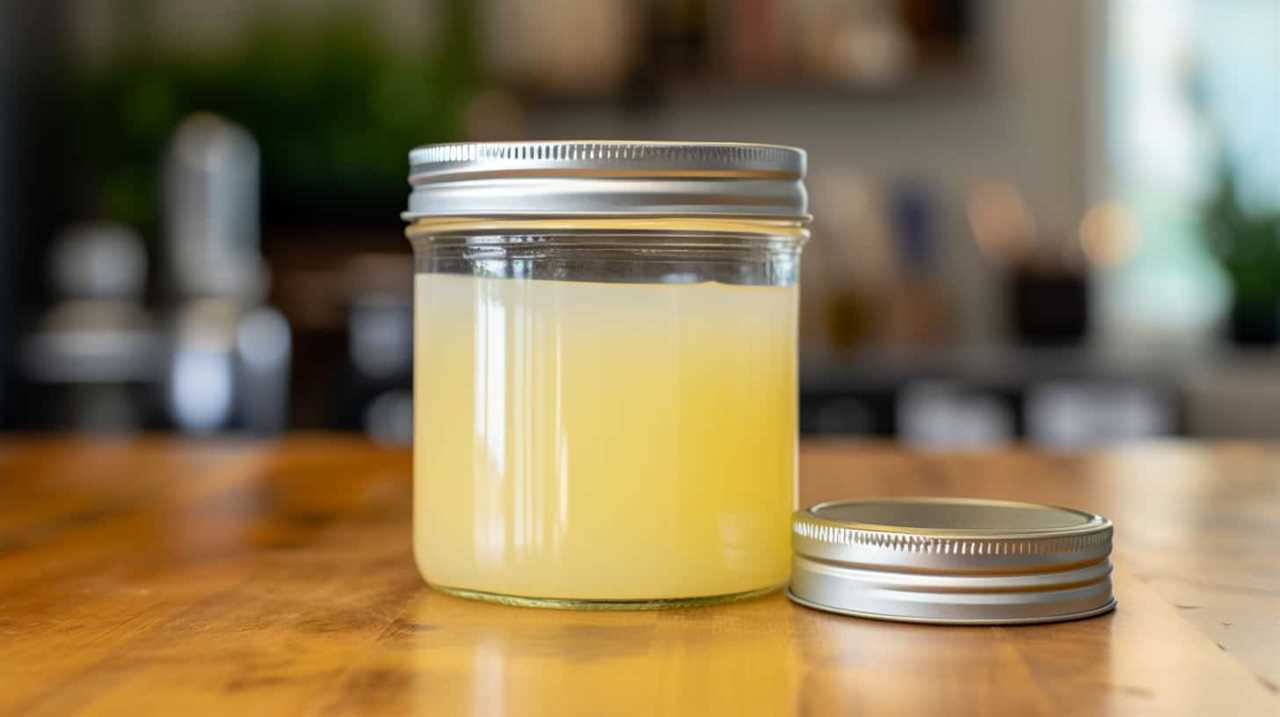
Comparing With Other Waxes
When comparing the melting point of soy wax to other waxes, we can see significant differences in their performance and suitability for various candle types and environments. Here are some key points to consider:
- Soy wax has a lower melting point compared to other waxes, typically ranging from 120-160°F (49-71°C).
- This lower melting point makes soy wax ideal for container candles, as it allows for a slower, more controlled burn.
- Soy wax has a longer burn time compared to other waxes, providing a longer-lasting candle experience.
- The lower melting point of soy wax also makes it easier to handle and work with during the candle-making process.
These differences in wax properties make soy wax a popular choice among candle makers looking for a versatile and high-quality wax option. Its unique melting point and performance characteristics contribute to its appeal in various candle-making applications.
Beeswax and Its Melting Point
In the article, we’ll explore the melting point of beeswax.
Beeswax, a natural wax produced by honeybees, is known for its unique properties and versatility in various applications.

When it comes to melting temperature, beeswax has a relatively low melting point compared to other waxes. The melting point of beeswax typically ranges between 144 to 147 degrees Fahrenheit (62 to 64 degrees Celsius).
This relatively low melting point makes beeswax an ideal choice for candles, as it allows for a slow and even burn. Additionally, the low melting point of beeswax makes it easy to work with in various crafts and skincare products.
Now, let’s move on to the next section where we’ll discuss palm wax and its melting point.
Palm Wax and Its Melting Point
Let’s delve into the melting point of palm wax, a commonly used wax in candle making, and explore its unique properties. Palm wax is derived from the oil palm tree and has gained popularity due to its eco-friendly nature.

Here are some key properties of palm wax and how it compares to other waxes in terms of melting point:
- Palm wax has a melting point ranging from 50 to 60 degrees Celsius.
- It has a higher melting point compared to soy wax, making it more suitable for warmer climates.
- Palm wax has excellent scent retention, allowing for a longer-lasting fragrance.
- Its smooth and creamy texture gives candles a luxurious appearance.
Understanding these palm wax properties and its melting point comparison lays a foundation for exploring blended waxes and their melting points.
Blended Waxes and Their Melting Points
When it comes to blended waxes and their melting points, there are several factors that come into play.
The composition of the blend, including the types and proportions of different waxes used, can greatly influence the melting point.
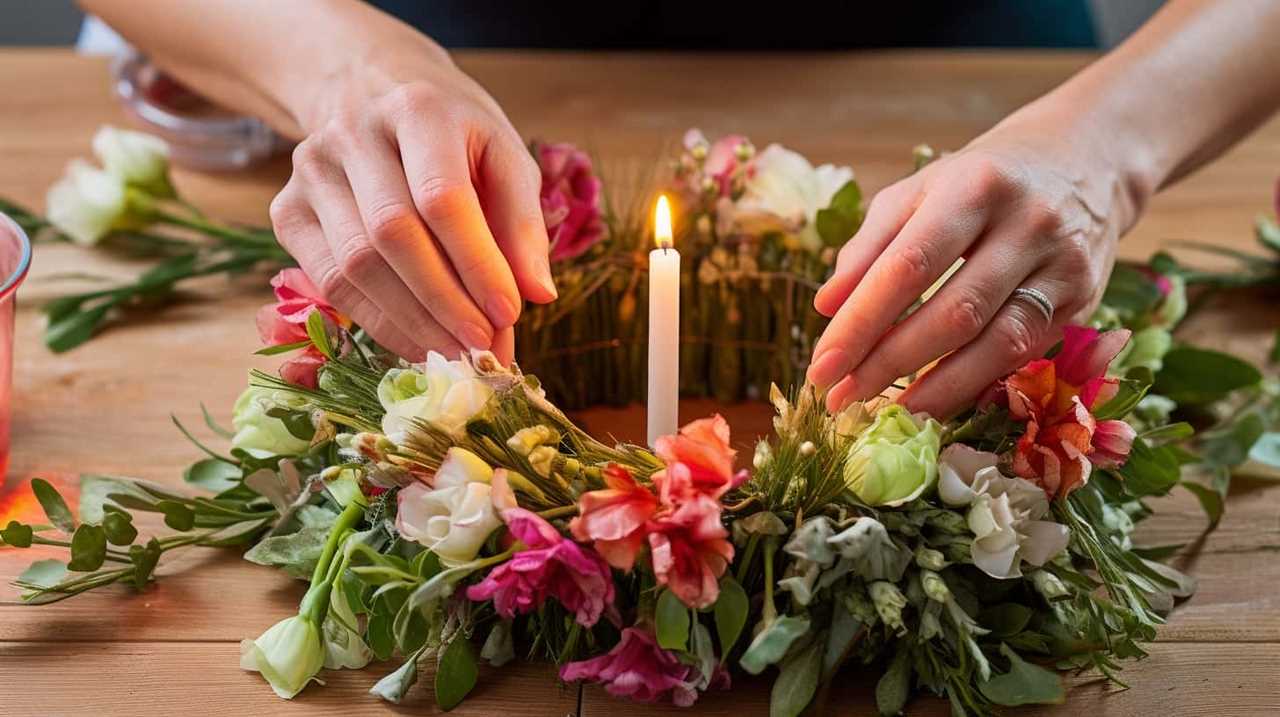
Additionally, additives or modifiers can also impact the melting point of the blend.
Factors Affecting Melting Points
We can explore the factors that influence the melting points of blended waxes by considering their composition and additives. Here are four key factors to consider:
- Molecular structure: The arrangement and size of molecules in the wax can affect its melting point. Waxes with longer hydrocarbon chains tend to have higher melting points, as the intermolecular forces between the molecules are stronger.
- Temperature control: The rate at which the wax is heated and cooled can also impact its melting point. Slow heating and gradual cooling can lead to a higher melting point, while rapid temperature changes can lower it.
- Additives: Certain additives, such as stearic acid or beeswax, can modify the melting point of the wax. These additives can either raise or lower the melting point depending on their chemical properties.
- Blending ratios: The proportions of different waxes in a blend can affect the overall melting point. Mixing waxes with different melting points can result in a blend with an intermediate melting point.
Understanding these factors is essential when comparing different wax blends and determining their suitability for specific applications.
Comparing Different Wax Blends
To compare different wax blends and their melting points, we can analyze the composition and additives of each blend. By understanding the properties of various waxes, we can determine the optimal melting temperature for different applications. The table below provides a comparison of three common wax blends used in candle making:

| Wax Blend | Composition | Melting Point |
|---|---|---|
| Paraffin | Petroleum-based | 130-150°F |
| Soy | Vegetable-based | 120-145°F |
| Beeswax | Natural beeswax | 144-147°F |
Paraffin wax, being petroleum-based, has a higher melting point compared to soy wax, which is derived from vegetable sources. Beeswax, a natural option, has the highest melting point among the three. When choosing a wax blend, it is important to consider the desired burning time, scent throw, and appearance. By comparing wax properties and their optimal melting temperatures, you can select the most suitable blend for your candle-making needs.
Practical Applications and Uses
For a variety of practical applications and uses, blended waxes with different melting points offer a range of options. These blends combine different types of waxes to create a desired melting point, enhancing their versatility and functionality.
Here are some practical uses of blended waxes and their benefits and drawbacks:
- Candle making: Blended waxes allow for customization of candle melting points, enabling the creation of candles that burn longer or have specific fragrance release profiles.
- Cosmetics and personal care products: Blended waxes are used in lip balms, lotions, and creams to provide desired consistency and stability.
- Adhesive and coating industries: Blended waxes with controlled melting points are used in adhesives and coatings to improve performance and durability.
- Food industry: Blended waxes find applications in food coatings, where specific melting points are required for proper adhesion and texture.
The benefits of blended waxes include enhanced flexibility, improved performance, and increased control over melting characteristics. However, drawbacks may include increased complexity in formulation and potential changes in other properties such as color or scent.
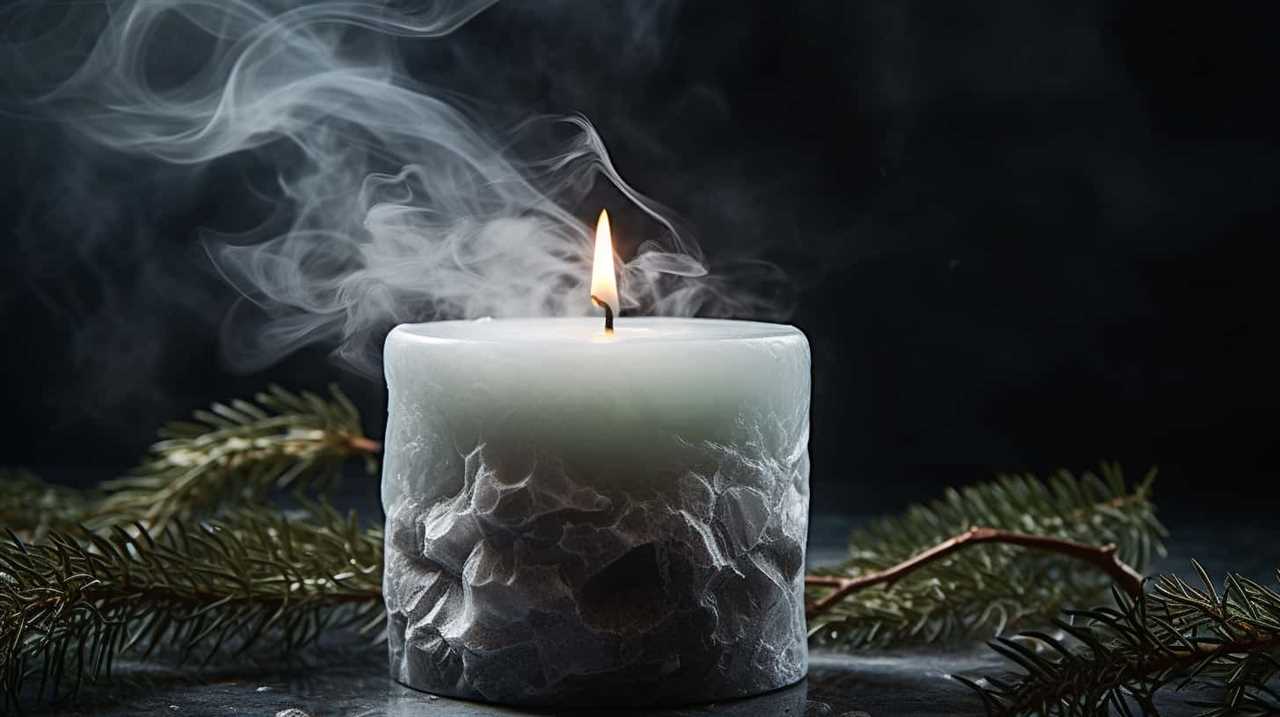
Testing and Determining Melting Point
Determining the melting point of candle wax involves conducting tests to measure the temperature at which it transitions from a solid to a liquid state. To achieve accurate results, various testing techniques can be employed. One common method is the capillary tube method, where a small sample of the wax is placed in a thin glass tube and heated slowly until it melts. The temperature is recorded when the first drop of liquid appears. Another technique is the hot stage microscopy, which involves observing the wax sample under a microscope while gradually increasing the temperature until melting occurs. This allows for precise determination of the melting point. To ensure temperature accuracy, calibrated thermometers and digital temperature probes can be used. These tools provide reliable and precise measurements, crucial for accurate melting point determination.
| Testing Technique | Description |
|---|---|
| Capillary Tube Method | A small sample of wax is heated slowly in a thin glass tube until it melts. The temperature is recorded when the first drop of liquid appears. |
| Hot Stage Microscopy | The wax sample is observed under a microscope while gradually increasing the temperature until melting occurs. This allows for precise determination of the melting point. |
Determining the melting point of candle wax requires careful attention to detail and accurate temperature measurements. By employing suitable testing techniques and ensuring temperature accuracy, one can obtain reliable results for this important property of candle wax.
Practical Applications of Melting Point in Candle Making
As we delve into the practical applications of the melting point in candle making, it becomes evident that understanding this property plays a crucial role in achieving desirable candle characteristics. The melting point of candle wax is a key factor in determining its burn time, scent throw, and overall performance.
Here are four practical applications of melting point in candle making:

- Control of burn time: By selecting a wax with a specific melting point, candle makers can regulate the rate at which the wax melts and therefore control the burn time of the candle.
- Scent release: Different fragrance oils have different flashpoints, which can affect the scent throw of a candle. By matching the melting point of the wax with the flashpoint of the fragrance oil, candle makers can optimize the release of the scent.
- Stability: Understanding the melting point allows candle makers to choose waxes that provide stability during the manufacturing process and when the candle is in use.
- Aesthetics: The melting point of wax can impact the appearance of a candle, influencing factors such as texture, color, and the formation of a desirable melt pool.
Frequently Asked Questions
How Does the Melting Point of Candle Wax Affect the Overall Burn Time of a Candle?
The melting point of candle wax directly influences the burn time and efficiency of a candle. By retaining heat at higher melting points, the wax burns more slowly and efficiently, resulting in a longer-lasting candle.
Can the Melting Point of Candle Wax Be Adjusted to Create Different Types of Candles, Such as Dripless or Scented Candles?
Yes, the melting point of candle wax can be adjusted to create different types of candles. This allows for the creation of dripless or scented candles, providing a more enjoyable and convenient experience for customers.
Are There Any Safety Concerns Associated With Using Candle Wax With a High Melting Point?
Safety precautions should be taken when working with candle wax with a high melting point. Proper temperature control is crucial to prevent burns or fires. It is important to handle the wax carefully and follow recommended safety guidelines.
How Does the Melting Point of Candle Wax Affect the Fragrance Throw of Scented Candles?
The melting point of candle wax directly affects the fragrance release and scent retention of scented candles. Higher melting points allow for longer burn times and better scent retention, resulting in a stronger and longer-lasting fragrance throw.

Can the Melting Point of Candle Wax Affect the Appearance or Texture of the Finished Candle?
The melting point of candle wax impacts its appearance and texture. A higher melting point results in a smoother texture and better moldability, while lower melting points can affect color and lead to a rougher finish.
Conclusion
In conclusion, understanding the melting point of candle wax is crucial for candle makers. By knowing the melting point, they can select the right wax for their desired candle characteristics. Factors like the type of wax and blending different waxes can also affect the melting point.
Testing and determining the melting point helps ensure the quality and performance of the candles. Overall, the melting point is a key factor in the art and science of candle making, like a compass guiding makers toward creating beautiful, long-lasting candles.










